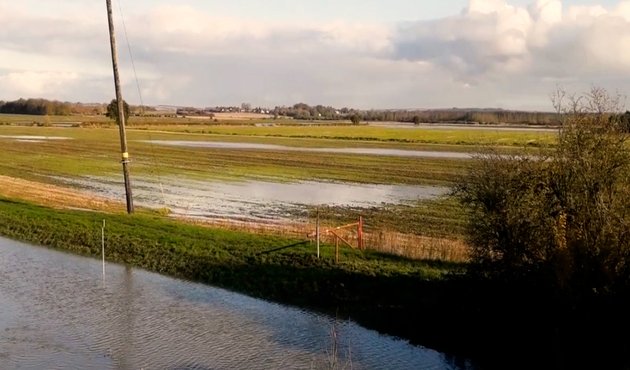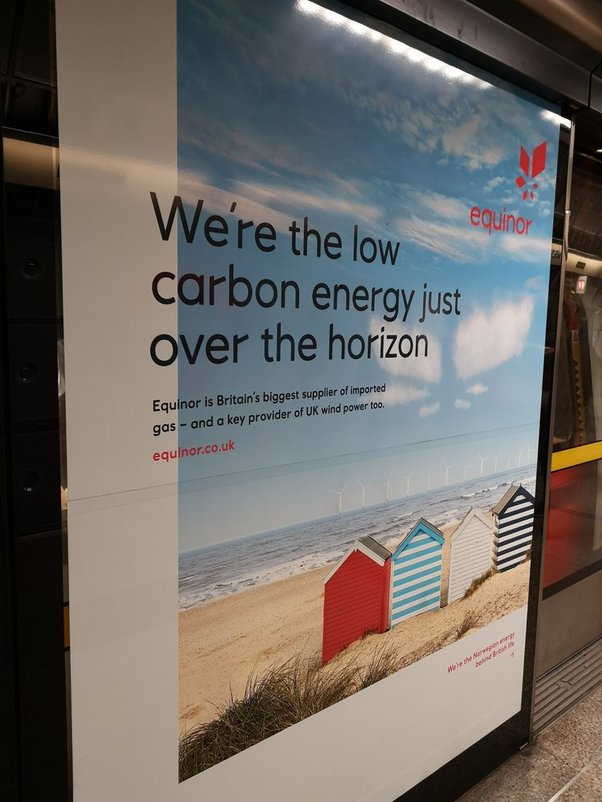Eight out of the top 10 most flood-prone constituencies in England are projected to elect a Reform MP at the next general election, new analysis by Global Witness and Round Our Way shows
Campaigners say the study shows that the government must take local climate protection seriously – or risk seeing their electoral chances severely dented.
The study comes after a report from the UK’s independent Climate Change Committee (CCC) warned that the UK is unprepared for climate impacts. Adaptation is urgently needed, the report says, to ensure that the UK is prepared for today’s extreme weather as well as the rapidly increasing severity of future risks.
Communities around the UK are already struggling with the impacts of climate change – often felt in the form of devastating floods that destroy homes and can cost families thousands. As today’s findings show, many of the communities at risk of being hardest hit may also be feeling cut adrift by the UK’s mainstream political parties.
The data shows that:
- The most flood-prone constituencies in England, according to the percentage of properties at medium or high risk of flooding from rivers and seas, are 1) Boston and Skegness; 2) South Holland the Deepings; 3) Goole and Pocklington; 4) North East Cambridgeshire; 5) Louth and Horncastle; 6) Selby; 7) Runnymede and Weybridge; 8) Great Grimsby and Cleethorpes; 9) Doncaster North; 10) Doncaster East and the Isle of Axholme
- Out of these constituencies, 8 out of 10 are projected to elect a Reform MP, according to data published this month by More in Common.
- On average, constituencies where Reform UK is projected to win at the next general election have the highest percentage of properties at risk of flooding compared to any other political party.
Yorkshire: Ex-Environment Agency engineer remains angry about 2020 floods near Goole
Dale Penistone, 65, worked for the Environment Agency in Yorkshire for more than 30 years, including as a flood duty officer. His experience with floods informed his decision to choose a particular location in the village of Snaith – near Goole, much of it a high risk area – to move to in 2008, despite knowing that a nearby village was previously badly hit by floods.
When the River Aire burst its banks in February 2020 it flooded around 100 homes nearby, but Mr Penistone’s house – chosen as it was on higher ground – was unscathed.
He said: “Water poured into some homes so quickly, and rose right up to the ceiling. Some Snaith residents escaped in the nick of time but lost everything they owned. It was heartbreaking.”
Five years on, Mr Penistone believes many homes could have been saved: “At the very least, if things had been done differently, residents could have been given time to get some of their belongings out,” he said.
Reflecting on the 2020 floods, he recalled his concern: “To see water flowing over an earthen bank in Snaith at a fair old rate; it shouldn’t have been. I knew something was very wrong. But I also knew the water could be slowed down, as in previous years.”
Despite raising the alarm in person to EA staff and by phone, he felt his concerns were ignored.
He said: “Some water could have been diverted, which had been done in previous years, meaning some of the flood could have been controlled. A big part of what went wrong in 2020 was a lack of local knowledge in the incident room, with office staff simply not understanding what was actually happening in the field.”
Though floods are now more frequent and severe now, he said: “There is still a poor level of investment in maintaining defences. It really worries me. I know some structures are a few decades old and are simply shot; they are leaking.”
Flossie Boyd, Senior Campaigner at Global Witness said:
“The climate crisis is no stranger to millions of us up and down the country. Every year people are experiencing the very real effects of it on homes, farms and towns, with wetter winters, extreme heat waves, and increasingly devastating storms.
“This data shows that taking climate measures, like flood defences, seriously, could be key to both protecting communities and winning over voters.
“To pay for it, politicians need to consider higher taxes on big business, like massively wealthy fossil fuel firms.”
Sofie Jenkinson, Co-Director at Round Our Way, a not-for-profit that supports people affected by the impacts of climate change, said:
“We are all sadly getting used to the erratic weather climate change brings, like heavier downpours that cause our rivers to flood more often. As this research shows, this is a big threat to many of our homes. It is therefore no surprise that polling shows the quiet majority of us want practical action from politicians – like cutting pollution and preventing more floods.
“Given that Reform is hoping to do well in many of the areas this analysis highlights are at high risk of flooding due to the weather extremes that climate change brings, it's odd to see them on TV busy questioning the basic science, which helps no one.”
Climate change has already begun to affect levels of rainfall in the UK, with a recent study from the CCC reporting there is now "unequivocal evidence" that climate change is making extreme weather in the UK, such as heavy rainfall, more likely and more extreme.
As the most recent Met Office State of the Climate Report illustrates, warmer skies hold more moisture, leading to both greater levels of rain and more sudden heavy downpours, which can overwhelm drainage systems and cause flooding.
Latest data from the Met Office UK State of the Climate Report found that 2023 was the seventh wettest year on record since 1836. March, July, October and December 2023 were all top-10 wettest months in the UK monthly rainfall series, the first year this has happened for four separate months.
Earlier this year a report by World Weather Attribution estimated that rainfall in the UK during Autumn and Winter 2023/24 was about a fifth heavier as a consequence of human-caused climate change.
We know that increasing rainfall and coastal erosion is increasing flood risk to properties across the country. The Environment Agency recently reported that around 6.3 million homes in England currently risk flooding, with an 88% increase in properties at risk from river- and sea- flooding compared to the previous year.
According to the same report, a further 1.7 million properties in England could be at risk of flooding by 2050 due to climate change.
Reform’s 2024 manifesto called for the scrapping of "net zero" targets and advocated for increased extraction of fossil fuels – climate u-turns that could lead to more extreme weather and flood-risk for many of its target voters.
Labour has said they are committed to reducing emissions in line with net zero targets for 2050, and recently announced £250 million more on flood defence spending. However, critics say their airport expansion plans and shelving of the Climate and Nature Bill are inconsistent with the party’s green ambitions.
The Conservative Party leader, Kemi Badenoch, recently ditched her party’s commitment to reaching Net Zero by 2050. She is reported to have scrapped the target after receiving donations from funders of a climate science denial group.
The Lib Dems say they want to move the UK’s net zero target forward to 2045, and at the last election promised an uplift in funding for the Environment Agency and Natural England. The Greens have called for a new wealth tax to help fund improvements to the Green Economy, an end to all new oil and gas extraction projects and more action on flood prevention.
/ ENDS
Notes to Editors
Data:
In England, based on risk of flooding from rivers and sea, and April 2025 MRP polling data:
- 8 out of the top 10 constituencies with the highest percentage of properties at high or medium risk of flooding are projected to elect a Reform MP
- 6 out of the top 10 constituencies with the highest percentage of properties at high risk of flooding are projected to elect a Reform MP
- 9 out of the top 10 constituencies with the highest percentage of properties at any risk of flooding are projected to elect a Reform MP
- The average (high, high or medium, any) flood risk is highest for constituencies where Reform UK is projected to win compared to any other political party.
- Reform UK is projected to win in constituencies where on average:
- 2.76% of properties are at high or medium risk of flooding
- 1.28% of properties are at high risk of flooding
- 10.21% of properties have any risk of flooding
Methodology:
We used flood risk data published by the Environment Agency, which provides constituency-level estimates of both the percentage and number of people or properties at risk of flooding. The data distinguishes between two causes of flooding:
- Flooding from rivers and the sea, including storm surges and rivers bursting their banks
- Flooding from surface water, which occurs when drainage systems are overwhelmed
For this analysis, we used the Flood Risk from Rivers and the Sea dataset.
We combined this with the latest MRP polling data released by More in Common to assess the relationship between flood exposure and projected electoral outcomes.
Flood risk is categorised into four likelihood levels:
- High – Greater than or equal to 1 in 30 (3.3%) chance of flooding in any year
- Medium – Less than 1 in 30 (3.3%) but greater than or equal to 1 in 100 (1%) chance of flooding in any given year
- Low – Less than 1 in 100 (1%) but greater than or equal to 1 in 1000 (0.1%) chance of flooding in any given year
- Very low – Less than 1 in 1000 (0.1%) chance of flooding in any given year
In our analysis, we focused on medium and high flood risk – i.e. properties with at least a 1% chance of flooding any given year.
We identified the top 10 constituencies with the highest percentage of properties with each level of flood risk and recorded the party projected to win.
We also calculated the average percentage of properties at each level of risk of flooding in each constituency, grouped by the party projected to win.



